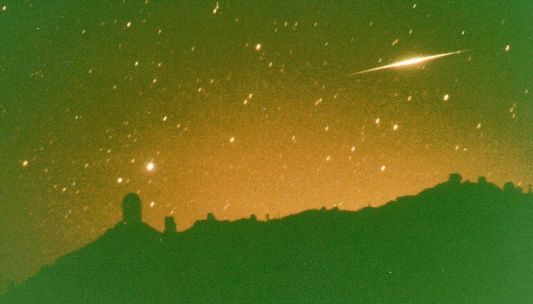
Telescopes I've Used (and what I've done with them)
I admit it - I'm a telescope junkie. Backyard, mountaintop, optical, infrared,
orbiting, any flavor. I do have the good fortune to be in a
profession that doesn't consider this too much of an aberration. To show
what kinds of projects can be done with various instruments (at least
the kinds I've thought of), here's a gallery of observatories and
telescopes I've used with some sample data and results. Since astrophysics
now has (and needs) access to much of the electromagnetic spectrum, there
are optical, infrared, radio, ultraviolet, and X-ray facilities to be found.
For each picture, a click will get you the full-sized version. There is a
mix of pictures of and data through each telescope. Where one
exists, I've included links to the "official" WWW sites for
these instruments, and to the TerraServer overhead imagery. Some of the
USGS images are included here. Some images
are still to be added, and all the listed sites will eventually have
their own information and image pages.
About the picture above: this 30-second exposure taken on 20 December 1999
shows a brilliant
flare (visual magnitude about -6) from the Iridium 62 satellite seen over
Kitt Peak, as viewed from MDM Observatory.
Lyra is rising in the background with Vega at left. More information
on Iridium flares (and other satellite viewing opportunities) may
be found at the Heavens-Above site,
especially now that the future of the
Iridium communications constellation is in less doubt than before.
Nashville - my back yard, Dyer Observatory
Lick Observatory - Crossley, Nickel 1m, Shane 3m, 0.5m astrographic telescopes
Mount Lemmon - 1.5m UCSD-UM telescope
Kitt Peak - 0.9m, 1.3m, 2.1m, 4m Mayall, WIYN telescopes
Lowell Observatory - 42" telescope
La Palma - JKT, INT, WHT, NOT
Bol'shoi Teleskop Azimutal'nyi, North Caucasus
Cerro Tololo - 1.5m, 4m Blanco telescopes
European Southern Observatory, La Silla - 2.2m, 3.6m telescopes
NASA Infrared Telescope Facility, Mauna Kea
MMT, Mt. Hopkins, Arizona
MDM Observatory - 2.4m Hiltner telescope
Palomar Mountain, California - 5-m Hale
telescope, Schmidt telescope, 1.5m telescope
SARA Observatory, Kitt Peak and Cerro Tololo - 0.9m telescope
ARC 3.5m telescope, Apache Point Observatory, New Mexico
Gemini Observatory, Mauna Kea and Cerro Pachon
UA's 16-inch reflector and its predecessor, the 10-inch refractor, in Tuscaloosa
NRAO: Very Large Array, 43m telescope
James Clerk Maxwell Telescope, Mauna Kea
Low Earth orbit - Hubble Space Telescope,
ROSAT, IRAS,
STS-95 Starlite, FUSE, GALEX
High Earth orbit - ISO,
Chandra
Geosynchronous orbit - IUE
Solar escape orbit - Voyager 2
In addition, I've got "tourist" pictures of some other instruments that
I haven't used, either because I haven't got an original use for
them or their operators have too much sense to let me on. Some are
hidden with their neighbors in the list above, and a few more at
additional sites are:
Bonn: Argelander's survey telescope
Byurakan: 1m Schmidt and 2.6m telescopes
Dwingeloo 25m radio telescope
Effelsberg 100m radio telescope
Jodrell Bank
Kuiper Airborne Observatory
Las Campanas: a distant view
Leander McCormick Observatory
Leiden: the old Sterrewacht
Mauna Kea: Keck, UKIRT, UH, Subaru,CFHT
McDonald Observatory - 107" including bullet holes
Mt. Bigelow - LPL 1.54-meter telescope
Mt. Hopkins: APTs, 60", Cerenkov high-energy array
Mt. Wilson: 60", and 100" Hooker telescopes, solar tower
NRAO: Green Bank, Kitt Peak, VLBA
Observatorio Astronomico Nacional,
Tonantzintla, Mexico
RATAN-600 radio telescope, North Caucasus
University of Havana observatory
US Naval Observatory: Flagstaff and Washington
Westerbork Synthesis Radio Telescope
Wyoming Infrared Observatory
Yerkes 40" refractor
Bill Keel's Home Page |
Astronomical Image Gallery |
Image Usage and Copyright Info |
UA Astronomy
keel@bildad.astr.ua.edu
Last changes: 5/2007 © 1999-2007

